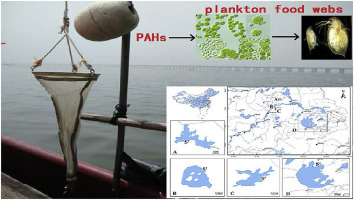Water Research ( IF 11.4 ) Pub Date : 2017-12-26 , DOI: 10.1016/j.watres.2017.12.053 Yuqiang Tao , Jing Yu , Xingrong Liu , Bin Xue , Sumin Wang

|
The biological pump plays a critical role in the occurrence and fate of hydrophobic organic contaminants (HOCs) mostly in temperate and frigid oligotrophic waters. However, the factors for the long-term occurrence and fate of HOCs in subtropical eutrophic waters remain largely unknown. This study provides novel insights into biogeochemical and physical factors on the annual occurrence, bioaccumulation, and biomagnification of 16 polycyclic aromatic hydrocarbons (PAHs) in the plankton food webs of four Chinese subtropical eutrophic lakes by one-year simultaneous field observations for five compartments. The annual mean ΣPAH16 in the water columns ranged from 359.69 ± 31.52 ng L−1 to 682.69 ± 65.41 ng L−1, and increased with the annual mean trophic state index, and phytoplankton biomass of these lakes, but was independent on the proximity of the lakes to urban areas. Biodilution effect played an important role in the occurrence of the PAHs in both phytoplankton and zooplankton. In contrast to previous studies in oligotrophic waters, not only the biological pump but also the equilibrium partitioning and the indirect influence of eutrophication (high pH induced by phytoplankton, and phytoplankton life cycling) modulated the annual occurrence of the PAHs in the water columns of these eutrophic lakes. Biphasic correlations were found between the bioaccumulation factors of the PAHs by plankton and the temperature (n = 97–136, R2 = 0.06–0.24, p ≤ .008), and were related to plankton phenology. Bioaccumulation factors by plankton were dependent on the hydrophobicity of the PAHs (n = 16, R2 = 0.27–0.31, p ≤ .023), and decreased with plankton biomass (n = 94–103, R2 = 0.09–0.27, p ≤ .010). Trophic transfer of the PAHs from phytoplankton to zooplankton increased with phytoplankton biomass (n = 26, R2 = 0.27, p = .004), and the temperature (n = 102–135, R2 = 0.06–0.13, p ≤ .004), but decreased with lake trophic state index. Biomagnification only occurred during phytoplankton bloom periods.











































 京公网安备 11010802027423号
京公网安备 11010802027423号